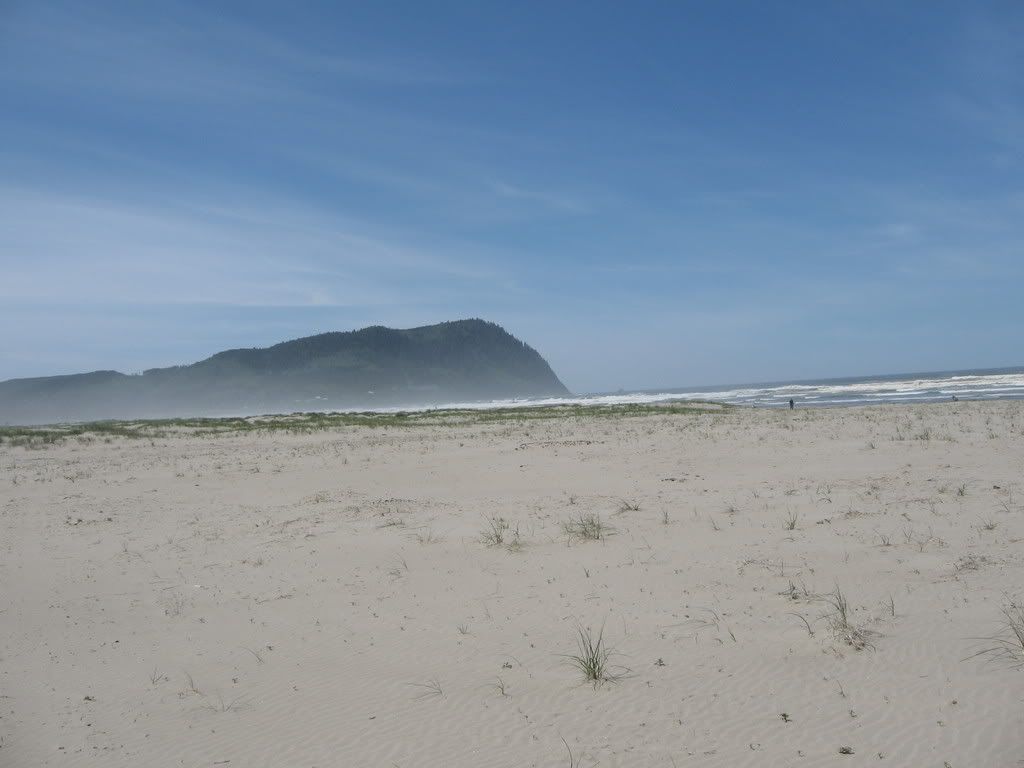 (click on the photographs for greater detail)
(click on the photographs for greater detail)The events depicted begin in the Pacific Northwest of present day North America at a time when there were no boundaries and no one to make boundaries. It begins, by most estimates, between 16 and 6 million years ago at a time when North America was just a place without a name, and no consciousness with a desire to name it and section it off from the rest of everything.
A lot of things were happening. Volcanic activity was rampant. There were an estimated 300 volcanoes active through this period. On top of that ice ages came one after the other in which snow would fall and accumulate to immense depths because of the low temperatures which prohibited melting. Then there would be periods of melting with temperature higher than they are today in the area. These periods of melting produced massive, cataclysmic flooding. Some estimate that these floods happened 30 to 60 times over a period of 2000 years. (The preceding and some subsequent information was gleaned from the book "Cataclysms On The Columbia" by John Eliot Allen and Marjorie Burns with Sam C. Sargent.)
The volcanoes during this period were not the Mt. Saint Helens type, but were the result of large, sometimes miles long fissures which opened up in the crust of the earth from which basaltic materials flowed quite rapidly and continued to flow off and on for millions upon millions of years. These are known as "shield-volcanic eruptions". They produced basalt material from the inside of the earth which accumulated on the surface in long flows as much as 6000 feet in depth. This material originated as far away as Idaho and ended up in solidified rock formations in the Pacific ocean along the north coast of Oregon.
Approximately a million years ago there was another ice age with continual snow accumulation and the subsequent development of a continental ice sheet extending down from what is now Canada into the present United States that was up to 4000 feet thick which formed into mammoth glaciers. These glaciers due to the great pressures exerted by their weight moved south. This tremendous amount of ice eventually formed dams, and subsequently, due to periodic melting, Lake Missoula: a huge body that contained more water than Lake Erie and Lake Ontario combined.
When the ice dam holding back Lake Missoula broke it unleashed a torrent equal to ten times that of all the existing rivers in the world
http://vulcan.wr.usgs.gov/Glossary/Glaciers/IceSheets/description_lake_missoula.html
allowing a wall of water 800 feet in height to escape in an unimaginable outpouring at an estimated speed of 65 miles an hour. The water and broken hunks of ice took with them top soil, huge rocks known as 'erratics' and the aggregate basalt material extruded by the previous volcanic activity on a trip to the Pacific Ocean. On its way the waters formed the present Columbia River gorge. The 'erratics' were dropped along the flood plain as the ice carrying them melted.
This link gives some photos of the area as explanation for the geological interpretation.
(copy and paste address into browser.)
http://www.glaciallakemissoula.org/virtualtour/index.html
As the water and the basalt carried with it reached the ocean the aggregate basalt materials cooled along the way and collected into sometimes massive formations.Haystack Rock, pictured above, in Cannon Beach Oregon is an example. The North Coast of Oregon from Lincoln City all the way to Astoria show remnants of this geologic activity.
Visible from the promenade at Seaside Oregon the Tillamook Head is impressive and shows what the flood from Lake Missoula resulted in.

(copy and paste the following web address.)
http://www.oregon.com/hiking/tillamook_head.cfm
Technical information for this was gleaned from this website.
http://vulcan.wr.usgs.gov/Volcanoes/ColumbiaPlateau/description_columbia_plateau.html
And so we come to the barnacles and the basalt.
Barnacles have been around for 400 million years in a relatively unchanged state. The glue they use to attach themselves to the place they wish to be is one of the most adhesive of any glues known to mankind.
http://www.evolutionnews.org/2008/07/billions_of_missing_links_part_3.html
 Barnacles are crustaceans related to shrimp
Barnacles are crustaceans related to shrimpstanding of their heads.
They maintain themselves by straining plankton
and absorbing oxygen with their legs
 They produce a powerful adhesive that is one of the strongest glues in the world able to support a weight of 7000 pounds with a film of only 3/10,000th of an inch. They attach themselves to a number of things including ships, rocks, pilings, and even whales.
They produce a powerful adhesive that is one of the strongest glues in the world able to support a weight of 7000 pounds with a film of only 3/10,000th of an inch. They attach themselves to a number of things including ships, rocks, pilings, and even whales.Threats to their well being include
but are not limited to, worms, star fish and oil spills.



making the rocks take on
the appearance
of a surreal flower garden
I find that acknowledging this sense of vast regions of time and change in which all we now are appeared in increments to be a comforting thought... a spiritual thought that connects me, rather than separates me, to everything. As the old hymn says; "as it was in the beginning it now and ever shall be. World without end."
It's difficult to imagine that life will ever end and that I will ever be separate from it even when this husk known as 'Me' is forever gone.
The photographs were taken at Cannon Beach, Oregon.
Text and photographs Copyright 2008 David H. Roche
































